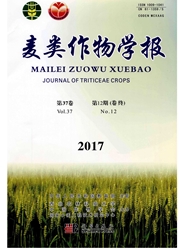

 中文摘要:
中文摘要:
为了探索弱筋小麦优质、高效、安全生产的杀虫剂使用方法,以扬麦13为材料,采用二因素随机区组设计,评价了三种化学杀虫剂在不同时期喷施对籽粒安全性和品质的影响。结果表明,三种化学杀虫剂在不同时期施用,均时小麦生长安全,不影响小麦的食用安全性。喷施化学杀虫剂后,显著降低籽粒蛋白质含量,显著提高淀粉含量。极显著提高蛋白质产量、淀粉产量和千粒重,RVA粘度特性大多教参数值上升,出粉率和弱化度显著提高,形成时间、稳定时间、评价值降低,而对拉伸仅参数无显著影响;吡虫啉和氧化乐果对品质改善的作用略大于毒死蜱。在抽穗开花期至花后7d喷施,可获得较高的千粒重、蛋白质产量和淀粉产量,同时蛋白质含量较低,淀粉含量较高,粉质参数中形成时间、稳定时间较低,弱化度较高,更有利于弱筋小麦品质的形成;喷施时期对扬麦13直链淀粉含量、总淀粉含量和RVA粘度特性参数、拉伸仪参数的影响较小,均未达到显著水平。药剂和喷施时期之间互作不显著。
 英文摘要:
英文摘要:
In the present study, the weak-gluten wheat Yangmai13 and three widely-used chemical pesticides of imidacloprid, chlorpyrifos and dimethoate, were used to explore the suitable spraying method of chemical pesticides in producing system of weak-gluten wheat for good-quality, high-efficiency and edible-safety. A two-factor random block design was adopted to conduct this experiment. Results indicated that the three chemical pesticides did not affect the growth and edible safety of Yangmai13. The grain quality of Yangmai13 was improved appreciably by spraying chemical pesticide. The protein content, starch content and 1000-kernel of Yangmai13 were highly significant increased after spraying the three chemical pesticides, however, no significant differences were observed among different chemical pesticides. The protein content declined and the starch content improved. The RVA parameters improved, and flour percentage and degree of softening were improved significantly, and development time, sability time, valorimeter value were declined. But extensograph parameters were not observably changed. Furthermore, spraying pesticides at the stage from heading to the 7th day after anthesis was much more advantage on the forming of grain quality of Yangmai 13. The protein content, starch content and 1000-kernel of Yangmai13 were higher. The protein content was lower, and the starch content was higher. The development time and sability time were lower, and degree of softening were higher. But amylase content, starch content and extensograph parameters were not observably changed. No significant interaction effects were observed among the chemical pesticides and the spraying stages.
 同期刊论文项目
同期刊论文项目
 同项目期刊论文
同项目期刊论文
 期刊信息
期刊信息
